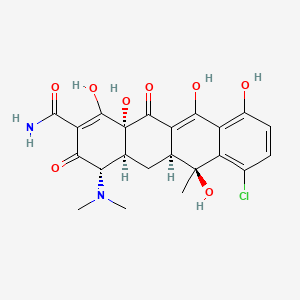Possible associated with:
| Structure | name | description | Reference count |
|---|---|---|---|

|
stearic acid | stearic acid is a lipid of Fatty Acyls (FA) class. Stearic acid is associated with abnormalities such as Helminthiasis, Exanthema, Chronic disease, Obesity and Dyslipidemias. The involved functions are known as acyltransferase activity, Mutation, Cell division, cell fate and Fatty Acid Metabolism. Stearic acid often locates in membrane fraction, Mouse Liver, Membrane, Body tissue and Endoplasmic reticulum, membrane. The associated genes with stearic acid are Homologous Gene, ACLY gene, Transgenes, FATE1 gene and Alleles. The related lipids are Lysophospholipids, Stearic acid, Fatty Acids, cis-vaccenic acid and Phosphatidylserines. The related experimental models are Knock-out. | 5692 |

|
erythromycin | erythromycin is a lipid of Polyketides (PK) class. Erythromycin is associated with abnormalities such as Systemic Inflammatory Response Syndrome, Pneumonia, Infection, Pneumococcal Infections and Exanthema. The involved functions are known as Pharmacodynamics, Sterility, Agent, Drug Kinetics and Adjudication. Erythromycin often locates in Blood, peritoneal, Extracellular, Ribosomes and apicoplast. The associated genes with erythromycin are P4HTM gene, SLC33A1 gene, FAM3B gene, Operon and Homologous Gene. The related lipids are Hydroxytestosterones, Steroids, Propionate, Mycolic Acids and campesterol. The related experimental models are Mouse Model and Knock-out. | 19871 |

|
Azithramycine | Azithramycine is a lipid of Polyketides (PK) class. Azithramycine is associated with abnormalities such as Respiratory Tract Infections, Pneumonia, Lower respiratory tract infection, Infection and Nonspecific urethritis. The involved functions are known as Lysis, Selection, Genetic, Mutation, Relapse and Adaptation. Azithramycine often locates in Blood, Respiratory System, Genitourinary system, Back and Chest. The associated genes with Azithramycine are Genes, rRNA, Genome, RPL22 gene, OPRM1 gene and tryptic soy broth. The related lipids are Liposomes, Phosphatidylserines, Promega, Lipopolysaccharides and Steroids. The related experimental models are Mouse Model, Knock-out and Tissue Model. | 7835 |

|
chlortetracycline | chlortetracycline is a lipid of Polyketides (PK) class. Chlortetracycline is associated with abnormalities such as Granulomatous Disease, Chronic, Infection, Ischemia, Cerebral Ischemia and Cerebral Infarction. The involved functions are known as Regulation, Binding (Molecular Function), Agent, Stimulus and Process. Chlortetracycline often locates in Protoplasm, Plasma membrane, Membrane, Cytoplasm and specific granule. The associated genes with chlortetracycline are FPR1 gene, P4HTM gene, Homologous Gene, HIST1H1C gene and Microbiome. The related lipids are Lysophosphatidylcholines, Sterols, dilauroyl lecithin, seminolipid and Total cholesterol. The related experimental models are Mouse Model. | 6144 |
Total
4